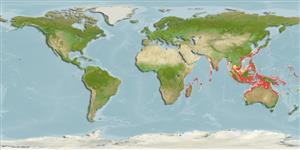>
Pleuronectiformes (Flatfishes) >
Bothidae (Lefteye flounders)
Etymology: Crossorhombus: Greek krossoi = tassel + Greek, rhombos = paralelogram (Ref. 45335).
More on author: Alcock.
Environment: milieu / climate zone / depth range / distribution range
البيئة
بحري القاع; نطاق العمق 13 - 60 m (Ref. 9824). Tropical
Indo-West Pacific: Bay of Bengal, northwestern Australia, South China Sea, China, Taiwan, Japan, Viet Nam, and Aru Islands, Indonesia.
الحجم / وزن / العمر
Maturity: Lm ? range ? - ? cm
Max length : 18.0 cm TL ذكر/ مختلط الجنس; (Ref. 9824)
الأشعة الظهرية الناعمة (المجموع) : 84 - 92; أشعه شرجية لينه: 63 - 74. Ground colour on eyed side brownish grey, with darker spots and blotches. Fins paler than body, dorsal and anal fins with small dark spots, caudal fin with 2 distinct dark bands. Males with small dark spots in anterior part of interorbital region. Blind side whitish in females. Males with distinct bluish black pyriform colour pattern on blind side. Body ovoid, its depth 1.7 to 2 times in SL. Head small, snout shorter than eye, profile steep anterior to interorbital area. Head length 3.3 to 4.5 times in SL. Interorbital region broad and concave, wider in males than females in specimens greater than about 6 cm SL. Males with a rostral spine and 1 to 3 low bony bumps around orbits. Both eyes on left side of head, front margin of upper eye slightly behind front margin of lower eye. Both eyes in males larger than about 6 cm SL with a flap on posterior area. Mouth small, reaching to or slightly beyond anterior margin of lower eye, length of upper jaw 3.1 to 4.3 times in head length. Teeth in upper jaw biserial, teeth of outer row more widely spaced than teeth of inner row; teeth in lower jaw uniserial. Gill rakers short and pointed. Scales on eyed side with long ctenii. Pectoral fin on eyed side with 11 to 14 rays, its length 1.3 to 1.6 times in head length in both sexes. Pectoral fin on blind side with 9 to 12 rays (Ref 42535).
Lives on mud bottoms and feeds on bottom-living animals (Ref. 9824). Sexually dimorphic characters develop at about 6 cm SL (Ref. 9824).
Life cycle and mating behavior
Maturities | التكاثر | Spawnings | Egg(s) | Fecundities | Larvae
Sainsbury, K.J., P.J. Kailola and G.G. Leyland, 1985. Continental shelf fishes of the northern and north-western Australia. An illustrated guide. CSIRO Division of Fisheries Research; Clouston & Hall and Peter Pownall Fisheries Information Service, Canberra, Australia. 375 p. (Ref. 3131)
IUCN Red List Status (Ref. 130435)
استخدامات بشرية
مصائد: غير ذات اهمية
أدوات
تقارير خاصة
Download XML
مصادر علي الأنترنت
Estimates based on models
Preferred temperature (Ref.
123201): 23.6 - 28.8, mean 27.2 °C (based on 460 cells).
Phylogenetic diversity index (Ref.
82804): PD
50 = 0.5312 [Uniqueness, from 0.5 = low to 2.0 = high].
Bayesian length-weight: a=0.00912 (0.00408 - 0.02036), b=3.05 (2.87 - 3.23), in cm total length, based on LWR estimates for this (Sub)family-body shape (Ref.
93245).
مستوى غذائي (Ref.
69278): 3.5 ±0.37 se; based on food items.
المرونه (Ref.
120179): وسيط, الحد الزمني الأدني لتضاعف عدد أفراد المجتمع 1.4-4.4 سنة (Preliminary K or Fecundity.).
Fishing Vulnerability (Ref.
59153): Low vulnerability (10 of 100).
